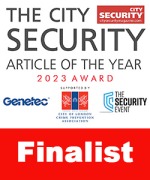5 critical steps to achieve an effective pedestrian entrance control solution
 Pedestrian entrance security is a key element of any building and now more than ever, there is a myriad of products, standards and certifications to choose from.
Pedestrian entrance security is a key element of any building and now more than ever, there is a myriad of products, standards and certifications to choose from.
What are the five critical questions to ask to detect, deter and delay those trying to gain unlawful entry?
Pedestrian entrance control can be a minefield but I think the key questions are often asked in the wrong order, if they are even asked at all. Given the high-profile nature of security and the potential (although very rare) risk of catastrophic failure (or even now, of being imprisoned) if you get it wrong, it is understandable that the risk is often outsourced to experts.
In my opinion, it is critical that the end user is heavily involved in the process as they are ultimately responsible for operating the building safely and paying for the solution. It is easy to be bamboozled by all the acronyms and technicalities, but I believe focusing on a few simple questions can help navigate through the maze and find a solution that is fit for purpose. Expert advice is needed and input from the end user is vital.
Remember first that no solution is 100%. Security is always a compromise and the list of questions below is designed to offer a guide as to how to manage those compromises – unless you have very deep pockets.
- What are the threats I am trying to mitigate? (Be thorough)
This may seem obvious but it is amazing how often just the headline threats are focused on (understandably). Try to be as complete as possible. You might be surprised as you progress through the process that a threat you barely considered could turn out to be a key one to focus on.
- How do they rank in terms of likely occurrence and likely impact?
A catastrophic terror attack might well destroy your business but is a relatively unlikely event whereas a member of the public being knocked over by an automatic door and suing you might be more likely and almost as bad for your business. You can get quite creative here, depending on your business, and include risk of loss of life, critical building infrastructure and cost.
- Where are the weakest links?
There’s no point in installing a security-class door if the glass next to it can be pierced more easily. Look at the whole building. Don’t kid yourselves that thieves aren’t smart. Consider also the location of potential ways into the building. Those that are out of sight, perhaps hidden to security cameras, might need a higher security rating than the main 24-hour manned reception entrance.
- What considerations do you need to make for usage (frequency and flow), safety and adherence to standards?
Once you are clear on the risk profile, you need to look at other elements of the solution such people flow, safety in use and standards. How many people will be using the building and what is the peak flow rate? For example, start of day/lunch/end of day, for a gym, times when certain classes might start.
Using your risk profile, how secure does the solution need to be? And think about how safe in use the solution must be. This will depend on the kind of users you have. Are there any children or vulnerable people using the building? Is it ‘trained’ people only (for example, staff or gym members) or is it public access (the latter is always, of course, more challenging).
What security standard do you want to reach? Any powered pedestrian door solution needs to meet BS EN 16005. Speed lanes and turnstiles should comply with the new BS EN 17352 standard. You may choose not to implement them but you need to understand the compromise you are making.
It is also worth asking the question when acronyms are cast around what they actually mean. For example, PAS24 and BS EN 1627 (up to RC3) are stealth standards aimed mainly at the domestic market where being relatively quiet is a key objective. If products have achieved these standards, how long are they designed to prevent ingress and with what capabilities and with what toolsets? You may not know, but your expert should. LPS1175 is a more comprehensive standard that grades the competence of the intruder and the range of tools being used along with the number of minutes delay being achieved.
- What is practical in terms of solution and budget?
You should now have a good idea of what you want to achieve and prioritised your risks. Just like when buying a house, you could rank them as ‘must haves’ and ‘nice to haves’. This will immediately rule out certain solutions. Cost is, of course, a factor. Be practical. Is it more cost effective and more secure to have more than one layer of security? Laminated glass is much stronger than the same thickness of one single pane. Remember ‘delay’ is a key element. Criminals are ultimately looking at getting in and out as quickly as possible compared with the potential reward.
If you have taken all the above into account you should be well placed to make an informed decision that will meet your security, safety and operational requirements. And, remember, security is ALWAYS a compromise between those elements.
Stephen Goodridge
SEC Business Development Manager
Record UK Ltd



